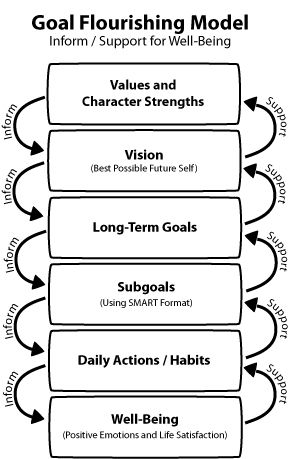Happiness
Breaking Free from American Happiness
Learn the Secrets to True Happiness & Well-being
Posted July 3, 2013
It's a great paradox: every year our entire country makes a big to-do in celebration of our independence—yet many of us feel imprisoned by the American lifestyle.
I've come to think that the real reason we all get so excited for the 4th of July is that we get to escape the daily grind for a few days, pig out on delicious food and play with explosives. I mean, who doesn't like fireworks, right?
But seriously, in light of the freedom that so many brave men and women have fought for, this is sad portrait of the American life. Very sad.
It's not that we've completely missed the mark on happiness as much as we’ve exchanged personal liberty for someone else's idea of bliss. Many of us have naively bartered a portion of our freedom for a vision of life, liberty and happiness that doesn’t personally fit us. It seems, instead of a declaration, it's become more a denial of independence. It was about five years ago when I discovered this great discrepancy in my own life.
The Unhappiness of Uninformed Pursuit
At that time, I was working on my master’s thesis. I had spent the previous four years working hard toward a meaningful goal, which seemed to make sense and feel right. But in the process I had lost touch with most of the things that truly mattered to me. And even though I had been studying positive psychology, and was steps away from attaining my goal, I realized that I wasn’t actually happy.
I've always been a real goal getter—ever since I can remember. I mean, I had known that striving for personal goals is something that is linked to well-being, but what I hadn’t understood until that “oh-crap moment” is that: in order to truly experience freedom, joy and life to the fullest, your goals must align with your personal values. Seems quite obvious, eh? Surprisingly, most people actually fail at choosing goals that resonate with their core values and personal interests.
I didn't have to begin by identifying what was wrong with my life. As soon as I looked at my values, I realized that I had been living out of alignment with the very things that mattered most to me. Up until that point, the driving force of my goals had been the values idealized within the American Dream—which after careful consideration I found out were fairly different from my own values. I was so out of touch with my own identity and what truly mattered to me that I had been pursuing a future that made me miserable in the present. Something had to change.
A New Strategy for Life, Liberty and Happiness
I believe that as a result of giving up personal freedom—in pursuit of the American Dream— we've also lost our personal identities. Aside from blindly pursuing American standards of happiness, one of the hardest parts to actually achieving some sense of life satisfaction is that we are bad predictors of what will actually make us happy in the future. We can’t predict what will make us happy because we don’t know who we are right now or what actually brings us joy. I mean, there’s plenty of competing marketing messages out there to tell us such things…but if those messages were truly onto something, wouldn’t more people in America be happy?
Being free—truly reveling in life, liberty and happiness—takes strategy. And it's more deliberate than the self-help, feel-good nostrum that most articles suggest. It takes knowing yourself—being informed about who you are and what makes you tick. I know it sounds kind of strange, but it works. Trust me; it’s how the most beautiful and wonderful changes in my life have come about.
You see, when you know who you are and what matters most to you, you can create a vision, define your goals and tackle the daily tasks that ultimately support the growth, realization and maximization of your best self. Here's what I’ve found to be the most effective model for reclaiming your freedom and happiness—a pursuit which brings your future, best self into the present. And yes, taking the time to process and write things out is important. After all, Edwin Locke, American psychologist and a pioneer in goal-setting theory, argues that the people who think their goals through with thoroughness and passion are the ones who are most likely to achieve them. These are the people who fight for their freedom and happiness!

1) Clarify (and prioritize) your personal values
As I said, most people make plans without first giving great consideration to what they actually believe in. By clarifying and prioritizing your core values it informs you of your ‘best future self’, and it sets you up for making choices that align with your heart. To do this, you can find values sort exercises online or purchase a book to guide you through the process. I like this one: What Matters Most: The Power of Living Your Values. Resources like this will help give you identify what is most important to you. Also, I recommend finding out what your signature strengths (top character strengths) are by taking the Values in Action Survey, which is a tool that measures which values you are most living out. I’ve taken the survey 5 times over the last several years, and there are 3 strengths that consistently show up as my top strengths: the capacity to love and be loved, leadership and hope/optimism. At the time when I discovered that I was pretty unhappy with the direction of my life, I realized that while I loved people, I was barely spending time connecting with them. Since then, I’ve built my life around connecting with people with an emphasis on learning how to love people better through small daily actions. Your values INFORM your vision.
2) Create a vision statement
Vision statements are future-oriented guidelines about what a person envisions their best future self to be. While the vision statement is more of a broad framework for conceptualizing your best future self, it informs which long-term goals will best enable you to work toward your own pursuit of happiness. Here’s the Best Future Selves Exercise (from the website of a colleague) that you can use—in conjunction with your values—to explore what you want for your future life. After completing this exercise, summarize your reflections into a solid vision statement. Your vision INFORMS your goals.
3) Write out long-term goals based on your vision statement
Though over the last few years, there’s been a lot of controversy over the value and danger of long-term goals, it’s a step that you cannot miss in the process. The problem with goals is that most people stop at that, and what they’re left with are vague ideas of what they think they want their life to look like (i.e. make more money, go back to school, buy a home). Visions and overarching, long-term goals are important because they set the stage for informing the subgoals (shorter-term goals) you need to pursue in order to realize long-term goals and work towards your ideal life. Your long-term goals INFORM your subgoals.
4) Break your long-term goals down into subgoals
Reducing long-term goals to subgoals can make change more manageable, easier to attain, and promote self-efficacy as the subgoals are achieved. Long-term goals are expansive; subgoals focus attention on the present. They are concrete, highlighting specific, manageable steps for creating a true plan of ‘action’. Your subgoals INFORM your daily actions.
5) Break subgoals down into daily/weekly/monthly actions
By the time you get to daily action, you can see that each step of this plan is informed by your personal core values and designed specifically for the pursuit of what matters most to you. This is where your future, best self meets the present, which leads to an upward spiral of autonomy and well-being.
Life, Liberty and the Happiness of Pursuit
The progression from defining your core values to enacting those values on a daily basis enables a life of enjoyment, meaning, engagement and freedom. In other words, actions that further your core values produce positive emotions and inspire a personal sense of commitment and motivation.
As I mentioned, this creates an upward spiral effect. Positive emotions support the creation of healthy habits and daily activities, which in turn supports the pursuit of subgoals. Subgoals support the realization of long-term goals, which subsequently support your progression towards your best future self. In turn, this supports the actualization of your values and strengths and adds a greater sense of autonomy and authenticity to your life. Living an authentic and meaningful life -- means knowing what personally matters most to you and creating an action plan to live out those values!
__
Angie LeVan, MAPP, is a resilience coach, speaker, trainer and writer, dedicated to helping individuals and organizations/businesses thrive!
Angie is available for presentations, workshops, media commentary, and private life coaching. For more information see: ajlevan.com.
__
Sources
Brown, K. W., & Ryan, R. M. (2004). Fostering healthy self-regulation from within and without: A self-determination theory perspective. In Linley, P. A. & Joseph, S. (Eds.), In Positive Psychology in Practice (pp. 105-124). Hoboken, NJ: Wiley.
Brunstein, J.C., Schultheiss, O.C., & Grassman, R. (1998). Personal goals and emotional well-being: The moderating role of motive dispositions. Journal of Personality and Social Psychology; 75, 494-508.
Canter, N. & Sanderson, C.A. (1999). Life task participation & well being : The importance oftaking part in daily life.
Carver, C. S., & Scheier, M. F. (1990). Origins and functions of positive and negative affect: A control-process view. Psychological Review; 97, 19-35.
Emmons, R.A., Colby, P.M., & Kaiser, H.A. (1998). When losses lead to gains: Personal goals and the recovery of meaning. In P.T.P. Wong & P.S. Fry (Eds.), The human quest for meaning (pp. 163-178). Mahwah, NJ: Erlbaum.
Hsee, C. K., & Hastie, R. (2006). Decision and experience: why don't we choose what makes us happy? Trends in Cognitive Sciences; 10(1), 31-37.
Latham, G.P. (2003). Goal Setting: A Five-Step Approach to Behavior Change. Organizational Dynamics; 32, 3, 309–318.
Locke, E. (1999). Motivation through conscious goal setting.Applied & Preventive Psychology 5:117-124.
Loewenstein, G. F., Weber, E.U., Hsee, C.K., & Welch, E. (2001). Risk as feelings. Psychological Bulletin; 127:267-286.
Lyubomirsky, S., Sheldon, K. M., & Schkade, D. (2005). Pursuing happiness: The architecture of sustainable change. Review of General Psychology; 9, 111-131.
Melchert, N. (2002). Aristotle: The reality of the world. The good life. In The great conversation: A historical introduction to philosophy, 4th ed. (pp. 186-198). Boston: McGraw-Hill.
Sheldon, K. M., & Houser-Marko, L. (2001). Self-concordance, goal attainment, and the pursuit of happiness: Can there be an upward spiral? Journal of Personality and Social Psychology; 80, 152-165.
Sheldon, K.M, & Lyubomirsky, S. (2006). Achieving sustainable gains in happiness: Change your actions, not your circumstances. Journal of Happiness Studies; 7:55-86.
Sheldon, K.M., Kasser, T., Smith, K., & Share, T. (2002). Personal goals and psychological growth: Testing an intervention to enhance goal-attainment and personality integration. Journal of Personality; 70, 5-31.
Sheldon, K.M. & Elliot, A.J. (1999). Goal striving, need-satisfaction, and longitudinal well-being: The Self-Concordance Model. Journal of Personality and Social Psychology; 76, 482-497.
Sheldon, K.M. & Kasser, T. (1995). Coherence and congruence: Two aspects of personality integration. Journal of Personality and Social Psychology; 68, 531-543.
Wilson, T. D. & Gilbert, D. T. (2005). Affective forecasting: Knowing what to want. Current Directions in Psychological Science; 14, 131-134.




